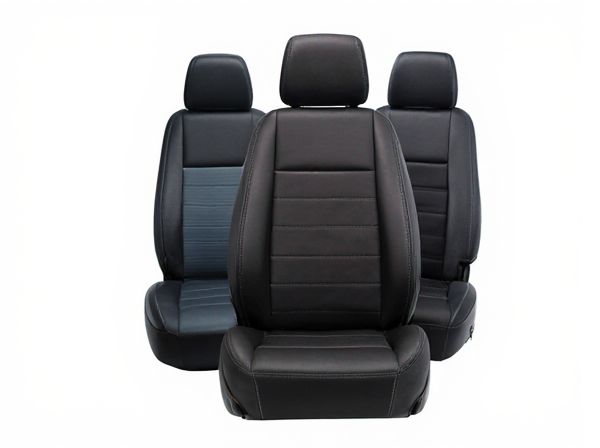
Photo illustration: Sports Seat vs Comfort Seat
A sports seat is designed to provide maximum support and stability during high-intensity driving with features like bolstered sides and firmer cushioning. Comfort seats focus on cushioning and ergonomic design to enhance your overall ride quality and reduce fatigue over long distances. Choosing the right seat depends on whether you prioritize driving performance or everyday comfort for your journeys.
Table of Comparison
| Feature | Sports Seat | Comfort Seat |
|---|---|---|
| Design | Ergonomic, contoured for support | Plush, cushioned for long drives |
| Materials | Durable leather or synthetic with bolstering | Soft fabric or leather with extra padding |
| Support | Enhanced lateral support to reduce body movement | Focus on lumbar and overall comfort |
| Adjustability | Limited, focused on driver position | Multiple adjustments including recline, height, and lumbar |
| Intended Use | Performance driving, sporty vehicles | Daily driving, long-distance comfort |
| Price Range | Higher due to specialized design | Moderate to high, prioritizing comfort features |
Introduction: Defining Sports Seat and Comfort Seat
Sports seats are designed with enhanced lateral support and firmer padding to provide stability and control during dynamic driving, often featuring pronounced bolsters and lightweight materials. Comfort seats prioritize cushioning, ergonomic design, and adjustable features to maximize relaxation and reduce fatigue during long journeys, typically incorporating softer foam and lumbar support. Both seat types aim to optimize the driving experience but cater to different priorities: performance-focused driving versus everyday comfort.
Key Differences Between Sports and Comfort Seats
Sports seats feature enhanced lateral support, firmer cushioning, and racing-inspired designs to improve stability and control during aggressive driving, while comfort seats prioritize plush padding, ergonomic contours, and adjustable features to maximize long-distance comfort and reduce fatigue. Sports seats often utilize materials like Alcantara or leather with bolstered side panels, whereas comfort seats incorporate softer fabrics and advanced lumbar support systems. The key difference lies in sports seats emphasizing performance and posture retention, whereas comfort seats focus on cushioning and adaptability for everyday use.
Ergonomics: Supporting Your Driving Posture
Sports seats feature bolstered sides and firmer cushioning designed to maintain optimal driving posture during dynamic maneuvers, reducing lateral movement and enhancing support. Comfort seats prioritize plush padding and adjustable lumbar support to promote long-term comfort and reduce fatigue on extended drives. Ergonomically, sports seats excel in stability for performance driving, while comfort seats focus on customizable alignment to support varying body types and prolonged use.
Materials and Build Quality Comparison
Sports seats are typically constructed with high-density foam and reinforced side bolsters using premium materials like Alcantara or leather to provide superior support and durability during dynamic driving. Comfort seats prioritize softer cushioning with memory foam or gel inserts, often combined with breathable fabrics for enhanced relaxation and long-distance comfort. Build quality in sports seats emphasizes rigidity and impact resistance, while comfort seats focus on ergonomic design and plush materials to maximize occupant ease.
Adjustability and Customization Features
Sports seats offer enhanced adjustability with features such as aggressive bolstering, adjustable thigh support, and customizable lumbar settings to provide optimal lateral support during dynamic driving. Comfort seats prioritize a broader range of customization options like multi-way power adjustments, memory settings, and integrated heating and cooling to maximize long-distance driving comfort. Advanced models in both categories can include massage functions and high-quality upholstery materials, but sports seats focus more on performance-driven ergonomics while comfort seats emphasize everyday luxury and adaptability.
Performance Impact: Handling and Driving Experience
Sports seats enhance performance by providing superior lateral support and stability during aggressive cornering, improving driver control and vehicle handling. Comfort seats prioritize cushioning and ergonomics, which may reduce fatigue on long drives but can compromise firmness needed for precise feedback. The firmer structure of sports seats enables quicker driver response and better connection with the car's dynamics, crucial for high-performance driving scenarios.
Comfort Considerations for Daily Commuting
Comfort seats prioritize ergonomic design with enhanced cushioning and lumbar support, making them ideal for daily commuting and extended periods behind the wheel. These seats often use softer materials and adjustable features to reduce fatigue and promote better posture during city traffic or long highway drives. Unlike sports seats, which emphasize lateral support and firm padding for dynamic driving, comfort seats focus on maximizing occupant relaxation and reducing pressure points throughout the commute.
Aesthetics: Sporty Looks vs. Classic Luxury
Sports seats emphasize aggressive contours, pronounced bolstering, and contrast stitching to enhance a dynamic, athletic appearance suitable for performance vehicles. Comfort seats showcase plush cushioning, smooth leather finishes, and refined detailing that exude timeless elegance and classic luxury. Both seat types balance form and function, with sporty looks appealing to enthusiasts while classic luxury targets those prioritizing sophistication and relaxation.
Price Range and Value for Money
Sports seats typically range from $300 to $1,200, offering enhanced lateral support and durability tailored for aggressive driving, making them a premium choice for enthusiasts seeking performance. Comfort seats vary between $250 and $800, emphasizing cushioning, adjustability, and ergonomic design for everyday use, delivering excellent value for buyers prioritizing relaxation and long-term comfort. Evaluating the price range against individual needs reveals that sports seats justify their higher cost with specialized features, while comfort seats provide affordable, versatile options for general driving satisfaction.
Choosing the Right Seat: Which Suits Your Needs?
Sports seats prioritize enhanced lateral support and firm cushioning to improve stability during dynamic driving, making them ideal for performance enthusiasts or drivers frequently navigating sharp turns. Comfort seats focus on ergonomic design with softer padding and adjustable features to maximize relaxation and reduce fatigue on long journeys, appealing to daily commuters or those valuing long-term comfort. Selecting the right seat depends on driving habits and preference for either performance-oriented support or cushioned comfort tailored to extended use.
 caratoz.com
caratoz.com